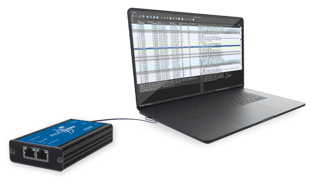Network packet capture, also known as packet sniffing or network traffic analysis, is the process of intercepting and logging data packets transmitted over a network. This technique allows for the detailed analysis of network traffic, providing crucial insights into the behavior and performance of a network.
Using a purpose-built tool like a Network TAP for optimal results is important. While other solutions may get you the traffic you’re looking for, there is a chance you’re losing valuable traffic information because of capture performance issues.

Network performance analysis
One of the main reasons why network packet capture matters is its significance in network performance analysis. By capturing and analyzing packets, organizations can identify potential bottlenecks, congestion points, and other issues affecting their network's performance. With this information, they can make informed decisions on optimizing their network infrastructure to ensure smooth and efficient data transmission.
Cybersecurity
Moreover, network packet capture plays a vital role in cybersecurity. Cyber threats have become increasingly sophisticated and challenging to detect in recent years. In many cases, traditional security measures such as firewalls and intrusion detection systems are insufficient to protect networks from malicious attacks. By capturing packets, organizations can closely monitor all incoming and outgoing traffic for any suspicious activity or anomalies that may indicate a cyber-attack. This allows for timely responses and mitigation of potential threats before they cause significant damage.
Data is evidence
Another reason why network packet capture is essential is that it provides critical evidence in case of a security breach or incident. The captured packets contain valuable information about the source, destination, content, and timing of each communication on the network. This level of detail can help forensic investigators identify an attack's root cause and determine its impact on the system.
Insufficient visibility into network activity is another issue that makes packet capture necessary. Traditional monitoring methods like NetFlow or log data only provide high-level summaries of network traffic. While these techniques help detect overall trends and patterns in traffic flow, they lack the granularity needed to identify specific devices or applications causing issues on the network.
NetFlow is not always sufficient
NetFlow is used in network monitoring to collect and analyze flow data, providing information on the source and destination of traffic and the volume and duration of each communication. However, NetFlow is not always sufficient for traffic analysis because it only captures summary data. This means that while NetFlow can help identify an issue on the network, it cannot provide details on the content or timing of specific communications.
This is where packet capture comes in. By capturing individual packets of data at the network level, packet capture provides a more detailed view of network activity. It records all communication between devices, including IP addresses, protocols, and application-specific data.
Furthermore, relying solely on NetFlow and log data may not provide an accurate picture of network activity. These techniques sample data at predetermined intervals, meaning they may miss critical events or traffic spikes. By capturing packets in real-time, organizations can get a complete and accurate view of their network's activity, ensuring that no critical information is overlooked.
More about the pros and cons of NetFlow and how IOTA addresses this here:
https://www.profitap.com/wp-content/uploads/NetFlow-vs-Metadata-vs-Packet-Inspection.pdf
How to capture network packets
Profitap has a range of purpose-built solutions that help accurately capture packets in different scenarios.
Network TAPs
Network TAPs can be deployed throughout the network at key capture points from where they forward a copy of the network traffic to connected monitoring and security tools.- Non-intrusive in-line network access
- For Copper, Fiber and Virtual networks
- Permanent network link guaranteed
- Passive, unpowered (fiber)
- Protect network link availability for in-line security tools
- Deliver lossless traffic aggregation from multiple in-line links or out-of-band connections (Profitap Booster)
ProfiShark
However, if you’re in the field, ProfiShark is a better fit as it provides a portable packet capture platform that forwards traffic over USB to a host PC or laptop.
- Ideal for field troubleshooting
- Get an exact trace file directly on your laptop
- Hardware filtering and timestamping
- Seamlessly integrate with existing industry-standard analysis tools such as Wireshark.
IOTA
IOTA is a powerful network capture and analysis solution for edge and core networks. The IOTA lineup consists of portable EDGE models, high-speed CORE models, and the IOTA CM centralized device management system.
- TAP, capture, and analyze on a single box
- Built-in analysis engine with dedicated dashboards.
- Remote access capabilities
- Perform both real-time and historical data investigation
- Achieve granular insights with packet-level visibility.
- Seamlessly integrate with existing industry-standard analysis tools such as Wireshark.
Conclusion
Network packet capture is a critical element in network performance analysis and cybersecurity. It provides valuable insights into the behavior and health of a network, helping organizations identify and resolve issues before they impact operations. Moreover, it serves as a crucial source of evidence in case of security incidents or breaches.
With proper packet capture techniques, organizations may gain more visibility into their network activity and rely on more accurate methods for monitoring and investigation. Investing in effective packet capture solutions is essential for any modern organization looking to maintain a secure and efficient network infrastructure.

